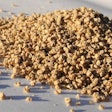Poultry is known to be less sensitive to fumonisin exposure than pigs and horses, but this does not mean that birds are immune to the effects of this mycotoxin, or that its presence in feed does not impact on meat and egg production.
The effects of fumonisin exposure were dramatically witnessed back in 1995, when two layer farms were seriously affected. The outbreak was characterized by black, sticky diarrhea; a severe reduction in the birds’ food intake, egg production and body weight; and followed by lameness and death. The mortality rate reached 10 percent, while egg production declined by 20 percent.
Analysis of the birds’ diets revealed contamination with fumonisin B1, up to 8.5 mg/kg in combination with aflatoxin B1 up to 0.1 mg/kg. At the time of the outbreak, the risks of fumonisin contaminated feed were not fully understood, and there continues to be less than a full appreciation of its impact on production.
Growing fumonisin regulation
In the mid-1990s, fumonisins were only subject to regulation in one country. The number of countries now regulating fumonisins has increased to six, with limits for maize ranging from 1,000-3,000 µg/kg.
Attitudes toward fumonisin control vary. In Europe, fumonisins are currently regulated in Bulgaria (FB1 and FB2 in maize and maize products), France (FB1 in cereals and cereal products), and Switzerland (FB1 and FB2 in maize). At the EU level, harmonized limits for fumonisins in food and feed are yet to be established, while in the U.S., limits for FB1, FB2 and FB3 in animal feeds currently only exist in the form of guidelines.
Lowest observed adverse effect
Available data suggest that the lowest possible adverse effect level in broilers is approximately 2 mg/kg body weight/day. This contrasts with European Commission recommendation 2006/576/EC (Table 2), which states that concentrations of fumonisin B1 and B2 below 20 mg/kg in complementary and complete feeding stuffs are considered “safe” for poultry.
So why should there be such a wide disparity between the lowest observed adverse effect level for broiler chickens at 2 mg/kg body weight/day and the European Commission’s recommendation of 20 mg/kg feed?
The key to this difference is that the EU Commission has simply published recommendations and not set regulations. Yet, farmers, feed millers and the large integrators tend to think that by respecting these recommendations, and keeping fumonisin levels under 20 mg/kg for complementary and complete feeds, they are erring on the side of caution and that their flocks will not be at risk.
There is extensive literature on the clinical and sub-clinical effects of individual mycotoxins in various livestock species, yet the effects of mycotoxin combinations have received less attention. Fumonisins act synergistically with fusaric acid and ochratoxin A, and have additional integrations with moniliformin and T-2 toxin.
Deactivation of mycotoxins
The most widely applied method for protecting animals against fumonisins is to mix clay minerals with feed to bind mycotoxins in the gastrointestinal tract.
An alternative way of removing non-absorbable mycotoxins is through enzymatic detoxification or biotransformation. This method is defined as degradation or transformation that reduces or removes the toxicity of mycotoxins. Specific mycotoxin-degrading enzymes offer a natural way of encouraging biotransformation in the digestive tract of animals.
It is known that the 12,13-epoxide ring of trichothecenes, for example DON, T-2 Toxin, is mainly responsible for their toxicity, and its removal leads to a significant reduction in toxicity. As for zearalenone, its metabolization by esterases produces a compound that is no longer estrogenic. In the case of fumonisins, fumonisin-degrading enzyme preparation is capable of fumonisin B1 biotransformation into non-toxic metabolite hydrolyzed FB1.
Could enzymes be the way forward?
Biological methods could become the technology of choice for mycotoxin deactivation, as enzymatic reactions offer a specific, irreversible, efficient and environmentally friendly way of detoxification that leaves neither toxic residues nor undesired by-products.
A 21-day study has looked at the efficacy of fumonisin degrading enzyme preparation Fumzyme in diminishing the toxic effects of fumonisin added to broiler rations. 600 day-old male broilers were randomly divided into four treatments, with 12 replicates and 10 birds in each replicate. On a weekly basis, the individual weight of the birds and feed intake per replicate were evaluated and, at the end of the trial, feed conversion rate and sphinganine:shingosine ratio were evaluated.
The negative effects of fumonisin were evident from the first week of the experiment, with the feed intake of the affected animals inferior to that of the control group. The addition of the fumonisin-degrading enzyme improved feed intake and the final body weight of the birds in a statistically significant way compared with birds given the fumonisin. This resulted in a better feed conversion rate for the supplemented birds. The accumulation of sphinganine and shpingosine in the serum and urine is a useful biomarker for exposure to fumonisins. These free shingoid bases are toxic to most cells as they affect cell proliferation, induce apoptosis or necrotic cell death, and are associated with hepato and nephrotoxic effects. Animals that consumed feed contaminated with fumonisin showed an increase in the sphiganine:sphingosine ration when compared with the control group (Fig. 1). The addition of the fumonisin-degrading enzyme decreased these values in a statistically significant manner.
Any feed is likely to contain grains from a variety of sources, so the risk exists that a variety of mycotoxins may be present. Considering and managing the entire potential risk along with correct farm management will improve birds’ health status, performance and profitability.






